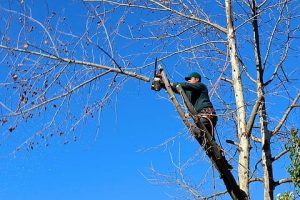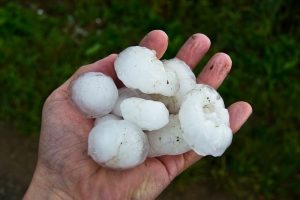With summer approaching, here’s everything you need to know about weathering San Antonio storm damage
As the calendar turns to spring, we approach some of the stormiest months of the year here in the Alamo City. San Antonio storm damage tends to be most common in the spring and early summer, and particularly May, when storms are most common. Depending on the type of storm, your home and roof may be hit with hail, high winds, flooding, or some combination of these sources of damage.
As storm restoration experts, at Dolan Roofing we feel that the first step in dealing with San Antonio’s all-too-common storm damage is to be informed. So today, we’ve put together a complete guide to storms and storm damage in San Antonio. We’ll be covering when to expect storm damage, what different kinds of damage can do to your home, and how to navigate the storm restoration process to fix your home. Let’s get started!
When is the stormy season in San Antonio?
San Antonio’s storm season typically falls in the spring and early summer months, with April, May, and June seeing increased amounts of rainfall and storm activity. It should also be noted that the Atlantic hurricane season, which peaks from mid-August to late October, impacts our weather here in San Antonio as well.
Most commonly, storms in San Antonio take the form of severe thunderstorms with heavy rains, lightning, and high winds. In some cases, these storms may produce hail, while in very rare cases storms may even result in tornadoes.
Has a tornado ever hit San Antonio?
Tornadoes are not unheard of in our area—in fact, two tornados touched down in Central Texas just last year. But rest assured, San Antonio is well outside of Tornado Alley, which is the peak area for tornado activity in the United States. Overall, the risk of tornadoes in San Antonio is lower than average within the state of Texas, but higher than the rest of the United States.
Has San Antonio ever had a hurricane?
In the strictest sense, not exactly. San Antonio is more than 120 miles away from the Gulf of Mexico. This means a “direct impact” from a hurricane is not really possible, as any hurricane impacting the Texas coast will be significantly weakened by the time it reaches San Antonio. However, high winds and flash flooding as a result of hurricanes are still very possible, especially when hurricane season peaks during the fall.
When was the last time it hailed in San Antonio, TX?
Compared to tornadoes and hurricanes, hail is much more of a common threat in San Antonio. Hail typically occurs several times per year in our area, and Texas overall is consistently one of the most hail-prone states.
How do storms affect my home?
Severe storms can damage your home in a variety of ways. Depending on the nature of the storm, your roof, siding, gutters, and more can all be damaged or otherwise compromised by heavy rains, high winds, and hail. Let’s take a look at how different types of weather can affect your home.
Hail damage and your roof
Here in San Antonio, hail is among the most common sources of storm damage. Hail affects your roof in a variety of ways. Very large hail can, of course, knock shingles or roof tiles loose and punch holes in roofing membranes. Large hail can also severely dent your gutters, necessitating a gutter repair, or damage your home’s siding.
Even small to medium-sized hail can create significant roofing issues, however. While smaller hail may not create obvious, catastrophic damage to your roof, it can weaken your roof by damaging roofing materials, leaving your home more exposed to the elements. Because it can be hard to tell when your roof has escaped hail damage entirely, it’s important to have your roof inspected by a professional immediately following a hail storm.
Wind damage
As with hail, high winds can damage your roof in a variety of ways. Wind can grab at loose roofing materials, tearing shingles from your roof or causing “tenting” on roofs covered by single-ply membranes that have deteriorated over time.
The best way to avoid damage from high winds is to have your roof inspected regularly. An expert roofer will be able to identify loose roofing materials that may be caught in high winds, preventing the need for more expensive repairs in the future.
Besides roof damage, wind is also a threat to the rest of your home’s exterior, particularly your siding. Debris such as sticks, rocks, and even small objects (such as tools, toys, or lawn chairs) can be flung into the side of your home, leaving dents in your siding. It’s a good idea to prepare your home by picking up such objects from your yard before a storm arrives.
Leaks and flooding
Storm season coincides with the rainy season, and issues such as flooding and roof leaks are fairly common in San Antonio. Flash flooding is especially common in our area, and this can cause damage to your home’s foundation and wash out your basement.
While your gutters can’t prevent flooding completely, they can certainly help avoid damage to your landscaping, foundation, and basement as a result of heavy rains. Effective roof drainage ensures that rainwater is whisked away. This keeps water off of your roof while directing it away from your home.
San Antonio storm damage: The restoration process
So your home has been hit by a major storm, and your roof or home exterior may have been damaged. Now what? Let’s break down the steps you should take in order to complete a storm restoration for your home.
First things first: Make sure you’re covered by insurance
Before a storm even strikes, it’s important to make sure your home is covered for potential types of storm damage common in your area. Here in San Antonio, that generally means you’ll want your roof protected from hail damage and your home protected from flooding, both of which are common threats.
Making sure your home is insured will help prevent headaches down the line. Rather than needing to worry about how you’ll restore your home from a flood or finance a roof replacement all on your own, insurance will generally help finance some or even all of your storm restoration needs.
Next, weather the storm
When severe storms are predicted in your area, it’s important to seek shelter promptly. If you have plenty of time before the storm arrives, there are a few actions you can take to protect your home and property. Loose objects in your yard can become projectiles when high winds arrive, so be sure to stow any objects you can somewhere safe. Be sure to park your car in a garage or carport as well, if possible.
During the storm, pay attention to weather updates. This is particularly important if hail is predicted in your area. Meteorologists will often describe the type of hail, if any, that is expected near your home. If the hail is large, you’ll know that damage to your roof or siding is more likely.
After the storm: Move quickly to identify damage
After a storm strikes in your area, the clock starts ticking. That’s because most insurance companies only allow a specific window of time following a storm in which you can file a claim for storm damage to your home.
The first step is to take a look around your property and check for signs of damage. You’ll likely notice damage to your siding, deck, or gutters right away, as these are all fairly visible from the ground. Spotting roof damage from hail or high winds can be trickier, however. If you spot debris, such as asphalt granules or shingles, this is a sure sign of roof damage.
The best thing to do for your home following a major storm is to schedule an inspection from a reliable roofer or home exterior contractor. An expert contractor will be able to identify all of the storm damage to your home. If your home survived unscathed, they’ll be able to confirm this as well!
The insurance claims process
If your home has been damaged, now comes the not-so-fun part for many folks: navigating the insurance claims process. As mentioned above, it’s important to file a claim promptly in order to maximize the likelihood that your provider will cover the damage to your home.
The good news is that Dolan Roofing has the expertise to help substantiate your insurance claim. We assist in the roof insurance claims process by taking pictures and gathering evidence as we inspect your roof and home exterior for damage.* We also send a representative roofer to walk the property during the adjustment to help point out any storm damage found during our inspection.
Completing your roof repair and home exterior restoration
Any damage to your roof or home exterior should be repaired promptly. If left unaddressed, this damage will leave your home vulnerable to the elements, and the next San Antonio storm is likely to cause even more significant (and more expensive) damage as a result.
When you work with a full-service contractor like Dolan Roofing & Construction, you get the convenience of having the same company repair all parts of your home’s exterior. Full-service contractors can repair or replace your roof, gutters, and siding, depending on the extent of the damage to each.
Maintenance can help avoid storm damage!

While especially severe storms are sure to damage even the healthiest of roofs, regular maintenance can often help avoid damage as a result of hail, high winds, and heavy rainfall. Here are a few examples of maintenance and upkeep tasks that can help protect your home:
- Have your roof regularly inspected by a professional roofer, generally at least once per year.
- Clean your gutters and/or drainage system regularly, at least in the fall (before winter) and ideally again in the spring.
- Trim loose branches from trees near your home, especially branches that hang over your roof.
Dolan Roofing Is Your Partner for San Antonio Storm Damage Restoration
Finally, another great way to keep your home protected from storm damage is to partner with a reliable San Antonio home exterior contractor. At Dolan Roofing, we’ve been in the roofing, home exterior, and storm restoration industries for many years. We’ve seen just about everything San Antonio’s weather has to offer, and we can repair all types of damage to your home.
As a local, family-owned business, our goal is to keep you and your loved ones safe, and we provide only the level of service and quality workmanship that we would expect for our own families. If your home has been damaged by a recent storm, or if you’re looking to prepare your home for the upcoming storm season, contact Dolan Roofing today!
* NOTE: DRC and its authorized representatives are NOT acting as Public Insurance Adjusters and will not negotiate with insurance on Customer’s behalf.





